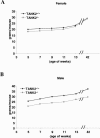Generation and characterization of telomere length maintenance in tankyrase 2-deficient mice
- PMID: 16507984
- PMCID: PMC1430286
- DOI: 10.1128/MCB.26.6.2037-2043.2006
Generation and characterization of telomere length maintenance in tankyrase 2-deficient mice
Abstract
Telomere length and function are crucial factors that determine the capacity for cell proliferation and survival, mediate cellular senescence, and play a role in malignant transformation in eukaryotic systems. The telomere length of a specific mammalian species is maintained within a given range by the action of telomerase and telomere-associated proteins. TRF1 is a telomere-associated protein that inhibits telomere elongation by its binding to telomere repeats, preventing access to telomerase. Human TRF1 interacts with tankyrase 1 and tankyrase 2 proteins, two related members of the tankyrase family shown to have poly(ADP-ribose) polymerase activity. Human tankyrase 1 is reported to ADP-ribosylate TRF1 and to down-regulate the telomeric repeat binding activity of TRF1, resulting in telomerase-dependent telomere elongation. Human tankyrase 2 is proposed to have activity similar to that of tankyrase 1, although tankyrase 2 function has been less extensively characterized. In the present study, we have assessed the in vivo function of mouse tankyrase 2 by germ line gene inactivation and show that inactivation of tankyrase 2 does not result in detectable alteration in telomere length when monitored through multiple generations of breeding. This finding suggests that either mouse tankyrases 1 and 2 have redundant functions in telomere length maintenance or that mouse tankyrase 2 differs from human tankyrase 2 in its role in telomere length maintenance. Tankyrase 2 deficiency did result in a significant decrease in body weight sustained through at least the first year of life, most marked in male mice, suggesting that tankyrase 2 functions in potentially telomerase-independent pathways to affect overall development and/or metabolism.
Figures




Similar articles
-
Tankyrase promotes telomere elongation in human cells.Curr Biol. 2000 Oct 19;10(20):1299-302. doi: 10.1016/s0960-9822(00)00752-1. Curr Biol. 2000. PMID: 11069113
-
Telomere elongation by a mutant tankyrase 1 without TRF1 poly(ADP-ribosyl)ation.Exp Cell Res. 2008 Mar 10;314(5):1115-24. doi: 10.1016/j.yexcr.2007.12.005. Epub 2007 Dec 14. Exp Cell Res. 2008. PMID: 18221737
-
Cross-species difference in telomeric function of tankyrase 1.Cancer Sci. 2007 Jun;98(6):850-7. doi: 10.1111/j.1349-7006.2007.00462.x. Epub 2007 Apr 13. Cancer Sci. 2007. PMID: 17433040 Free PMC article.
-
The telomeric PARP, tankyrases, as targets for cancer therapy.Br J Cancer. 2006 Feb 13;94(3):341-5. doi: 10.1038/sj.bjc.6602951. Br J Cancer. 2006. PMID: 16421589 Free PMC article. Review.
-
Tankyrase function at telomeres, spindle poles, and beyond.Biochimie. 2008 Jan;90(1):83-92. doi: 10.1016/j.biochi.2007.07.012. Epub 2007 Jul 24. Biochimie. 2008. PMID: 17825467 Review.
Cited by
-
The Axin/TNKS complex interacts with KIF3A and is required for insulin-stimulated GLUT4 translocation.Cell Res. 2012 Aug;22(8):1246-57. doi: 10.1038/cr.2012.52. Epub 2012 Apr 3. Cell Res. 2012. PMID: 22473005 Free PMC article.
-
Analysis of poly(ADP-Ribose) polymerases in Arabidopsis telomere biology.PLoS One. 2014 Feb 13;9(2):e88872. doi: 10.1371/journal.pone.0088872. eCollection 2014. PLoS One. 2014. PMID: 24551184 Free PMC article.
-
TRF1 controls telomere length and mitotic fidelity in epithelial homeostasis.Mol Cell Biol. 2009 Mar;29(6):1608-25. doi: 10.1128/MCB.01339-08. Epub 2009 Jan 5. Mol Cell Biol. 2009. PMID: 19124610 Free PMC article.
-
Whole proteome analysis of human tankyrase knockout cells reveals targets of tankyrase-mediated degradation.Nat Commun. 2017 Dec 20;8(1):2214. doi: 10.1038/s41467-017-02363-w. Nat Commun. 2017. PMID: 29263426 Free PMC article.
-
Telomere dynamics: the means to an end.Cell Prolif. 2007 Aug;40(4):462-74. doi: 10.1111/j.1365-2184.2007.00452.x. Cell Prolif. 2007. PMID: 17635515 Free PMC article. Review.
References
-
- Baerlocher, G. M., J. Mak, T. Tien, and P. M. Lansdorp. 2002. Telomere length measurement by fluorescence in situ hybridization and flow cytometry: tips and pitfalls. Cytometry 47:89-99. - PubMed
-
- Baumann, P., and T. R. Cech. 2001. Pot1, the putative telomere end-binding protein in fission yeast and humans. Science 292:1171-1175. - PubMed
-
- Blackburn, E. H. 2005. Telomeres and telomerase: their mechanisms of action and the effects of altering their functions. FEBS Lett. 579:859-862. - PubMed
-
- Blasco, M. A., H. W. Lee, M. P. Hande, E. Samper, P. M. Lansdorp, R. A. DePinho, and C. W. Greider. 1997. Telomere shortening and tumor formation by mouse cells lacking telomerase RNA. Cell 91:25-34. - PubMed
Publication types
MeSH terms
Substances
Grants and funding
LinkOut - more resources
Full Text Sources
Molecular Biology Databases
Research Materials
